Abstract
(1) Introduction: Psoriasis is a chronic, immune-mediated disease that negatively impacts patients’ quality of life and predisposes them to cardiovascular or metabolic diseases. This paper aims to summarize the knowledge structure and future directions in psoriasis research by means of bibliometrics. (2) Material and methods: The Thomson Reuters Web of Science database was interrogated using preestablished keywords. A list of the top 100 most cited articles focusing solely on psoriasis was compiled and analyzed. VOSviewer software was used to assess and visualize collaboration networks, citation, co-citation and co-wording analysis, and bibliographic coupling. (3) Results: The articles were written by 902 authors from 20 countries and were published in 31 journals. The United States was at the forefront of this field. Griffiths, CEM had the most citations, while the most prolific institution was Rockefeller University, New York City. Pathogenesis, especially key-pathogenic factors, immune pathways, and epidemiology were the most discussed topics. Work published in the last decade focused on the use of biologics. Keywords such as “quality of life”, “efficacy”, and “necrosis-factor alpha” have been widely used. (4) Conclusion: Research interest regarding psoriasis is high, leading to the rapid development of this field. Treatment modalities, especially novel-targeted therapies, immune pathways, and an integrative approach to such cases are receiving great interest and represent research hotspots in the future.
1. Introduction
Psoriasis is a chronic, immune-mediated disease that negatively impacts patients’ quality of life (QoL). In the last published global report [1], the World Health Organization reported an increasing prevalence of psoriasis, ranging between 1.5% and 5% in developed countries [2]. Its etiopathogenesis is complex, with genetic predisposition, an altered immune response, and various triggering factors concurring in the development of this disease [3,4]. Clinically defined by cutaneous erythema, scaling, and induration, and in some cases by joint and nail involvement, this disease seems to predispose patients to a higher risk of developing cardiovascular disease, diabetes, dyslipidemia, and metabolic syndrome [5,6].
A continuous stream of research is being conducted in relation to psoriasis, aiming to shed light on the pathogenesis, management, and therapeutic outcomes of this disease. A thorough study of scientific advances in a specific field may lead to improvements in the diagnosis and treatment of various diseases. In order to evaluate progress in psoriasis research and its future directions, a bibliometric analysis is of great use.
This concept was proposed by Pritchard [7] and uses statistical parameters to identify emerging trends and collaboration patterns between research constituents. Citations are the most forthright measure of a paper’s impact [8]. Additionally, performance analysis, which illustrates the contributions of research constituents, and science mapping, which depicts the relationships between them, provide additional insight into the academic significance of research papers.
Nevertheless, the use of bibliometry in medical research is relatively new. It has been sparsely utilized, especially regarding cancers [9,10,11,12,13]. However, to the best of our knowledge, this is the first paper to address overall research directions in psoriasis, taking into account bibliometric algorithms based on the top 100 most cited articles referring to this disease.
2. Material and Methods
2.1. Search Strategy and Data Collection
The search was conducted on the Thomson Reuters Web of Science (WoS) database on 15 January 2023. The following keywords were used: “psoriasis”, “plaque psoriasis”, “guttate psoriasis”, “erythrodermic psoriasis”, and “pustular psoriasis”, separated by the Boolean OR. Articles from all fields were searched across the entire database without regard to article type or study design. Citations recorded in the indexing database are as follows: Science Citation Index Expanded, Social Sciences Citation Index, Conference Proceeding Citation Index-Social Science and Humanities, Conference Proceedings Citation Index-Science, and Emerging Sources Citation Index.
The search returned 56,731 results, that were afterward screened. Abstracts and letters were excluded. Only full-length English articles were considered. The returned articles were sorted by citation count using Paladugu’s method [14]. Articles focusing on psoriatic arthritis or other inflammatory or autoimmune skin disorders were excluded. Papers referring only to psoriasis-specific topics, such as pathogenesis, treatment modalities, or outcomes, were reviewed. Search and screening of the results were made by two independent researchers to ensure relevance to the selected topic. Disagreements were resolved by discussion between the two involved researchers. The Prisma diagram (Figure 1) exemplifies the workflow. A list of the top 100 most cited articles was compiled and analyzed for various parameters over the next four weeks [15,16,17,18,19,20,21,22,23,24,25,26,27,28,29,30,31,32,33,34,35,36,37,38,39,40,41,42,43,44,45,46,47,48,49,50,51,52,53,54,55,56,57,58,59,60,61,62,63,64,65,66,67,68,69,70,71,72,73,74,75,76,77,78,79,80,81,82,83,84,85,86,87,88,89,90,91,92,93,94,95,96,97,98,99,100,101,102,103,104,105,106,107,108,109,110,111,112,113,114].
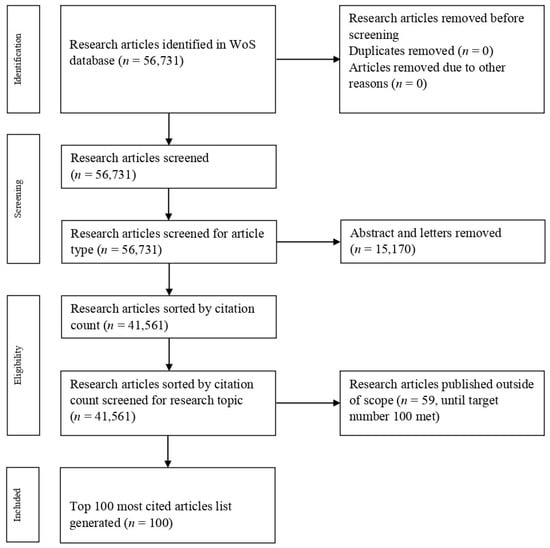
Figure 1.
Prisma diagram of workflow.
2.2. Bibliometric Analysis
Information regarding the journal, authorship, institution, publication year, and study design was extracted for the selected articles. Clarivate Journal Citation Reports was used for each journal’s 2021 and 5-year impact factors. Full data regarding the selected articles were generated from the WoS database as an Excel spreadsheet and as a plain text file.
Publication-related metrics were analyzed with Microsoft Excel software. Science mapping and data visualization were performed with VOSviewer software (Version 1.6.19-2023). VOSviewer is a graphical user interface-based free software first developed by van Eck and Waltman in 2010 [115], with the latest version launched on 23 January 2023. It allows the analysis and visualization of different collaboration patterns between research constituents.
The following performance analysis parameters were evaluated: publication-related metrics (total publications, solo-authored publications, co-authored publications) and citation-related metrics (total citations and citation rate). The citation rate was calculated by dividing the total number of citations by the number of years since publication. The bibliometric and knowledge structure of the research field is evaluated in this paper by using the following science mapping techniques: citation, co-citation, co-word, co-authorship analysis, and bibliographical coupling. The counting method was set at full counting. To limit spelling differences in authors’ or institutions’ names an additional thesaurus file, that gives consistent labels to the same word spelled differently, was generated, and used when appropriate.
3. Results
3.1. Citation Analysis
The total citation count for the analyzed articles was 68,691, with a median of 553.5 and a mean of 686.91. Eighty-four were original articles, while sixteen were reviews. Pathogenesis and epidemiology were the topics most discussed (n = 66), followed by management (n = 45) and genetics (n = 9). Twenty-six articles focused on the use and effectiveness of novel targeted immune therapies, such as biologics, in the management of moderate-to-severe plaque psoriasis. Pustular psoriasis was addressed in two articles [45,63].
Within the top 100, the citation count ranged between 405 for “Clinical response to adalimumab treatment in patients with moderate to severe psoriasis: Double-blind, randomized controlled trial and open-label extension study” by Gordon, K et al. [28] and 2145 for “Severe psoriasis—oral therapy with a new retinoid” by Fredriksson, T et al. [106].
The articles were published between 1969 and 2020. The oldest article was “Generalized pustular psoriasis—a clinical and epidemiological study of 104 cases” by Baker, H et al. [45], while the newest one was “Pathophysiology, clinical presentation, and treatment of psoriasis: a review” by Armstrong, AW et al. [73]. They had 421 and 420 citations, respectively. These two articles also have the lowest and highest citation rates, 8 and 211, respectively. Table 1 shows the top 100 articles and their respective citation rates. Figure 2 illustrates the distribution of the articles by decade.

Table 1.
Top 100 articles ranked by citation count [15,16,17,18,19,20,21,22,23,24,25,26,27,28,29,30,31,32,33,34,35,36,37,38,39,40,41,42,43,44,45,46,47,48,49,50,51,52,53,54,55,56,57,58,59,60,61,62,63,64,65,66,67,68,69,70,71,72,73,74,75,76,77,78,79,80,81,82,83,84,85,86,87,88,89,90,91,92,93,94,95,96,97,98,99,100,101,102,103,104,105,106,107,108,109,110,111,112,113,114].
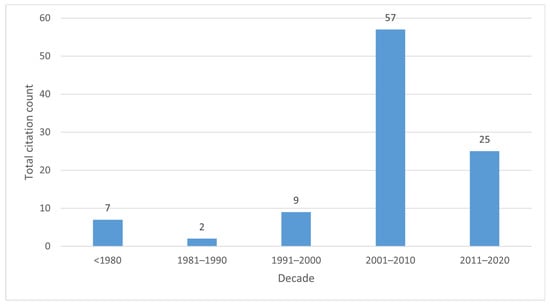
Figure 2.
Articles distribution by decade.
Based on bibliometric algorithms that consider citation patterns, such as total citation number and the topic addressed in these papers, the analyzed articles were grouped into eight clusters. Cluster 1 is defined by 24 articles, clusters 2 and 3 by 16 articles each, cluster 4 by 15 articles, cluster 5 by 14 articles, cluster 6 by 9 articles, cluster 7 by 5 articles, and cluster 8 by a single article. The previously mentioned clusters are shown in Figure 3 as map-based connections. Each color represents a thematic cluster, whereas each node represents an author. The size of each individual node and font size is proportional to the number of citations, both related to the completed data set and to each individual cluster.
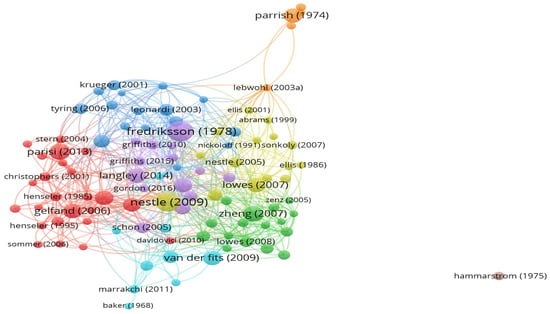
Figure 3.
The bibliometric map of the selected articles based on citation patterns. (Cluster colors are as follows: cluster 1—red, cluster 2—green, cluster 3—blue, cluster 4—yellow, cluster 5—purple, cluster 6—turquoise, cluster 7—orange, cluster 8—pink) [15,16,17,18,19,20,21,22,23,24,25,26,27,28,29,30,31,32,33,34,35,36,37,38,39,40,41,42,43,44,45,46,47,48,49,50,51,52,53,54,55,56,57,58,59,60,61,62,63,64,65,66,67,68,69,70,71,72,73,74,75,76,77,78,79,80,81,82,83,84,85,86,87,88,89,90,91,92,93,94,95,96,97,98,99,100,101,102,103,104,105,106,107,108,109,110,111,112,113,114].
Griffiths, CEM, Krueger, JG, Papp, K, Krueger, GG, and Menter, A contributed to the greatest number of articles and received a total of 9646, 7669, 8944, 7492, and 6945 citations, respectively. Table 2 highlights the top 10 most cited authors.

Table 2.
Most cited authors.
The top 100 articles were published in 31 journals, which published between one and sixteen articles. New England Journal of Medicine (n = 16) published the greatest number of articles within the top 100 and had the highest number of citations (12,817). Lancet had the highest impact factor (202.73), published the third-highest number of articles (n = 10), and received the third-highest number of total citations (8966). Dermatologica had the highest average citation per publication (1301), having published 2 papers with a total of 2602 citations. Table 3 displays articles, citation count, and various journal metrics.

Table 3.
Journal metrics.
3.2. Co-Authorship Analysis
The 100 analyzed articles summed 902 authors, out of which 167 contributed to more than 2 papers, while 18 authored more than 5 articles. Three papers were solo-authored [84,86,111]; the highest number of contributing authors for a paper was 136 [49]. Leonardi and Papp first authored the highest number of papers (n = 3). Griffiths, CEM (n = 12), Krueger, JG (n = 12), Papp, K (n = 11), Krueger, GG (n = 10), and Menter, A (n = 10) contributed to the greatest number of articles. The authors who contributed to more than five papers are shown in Figure 4 as map-based connections scored by average citations.
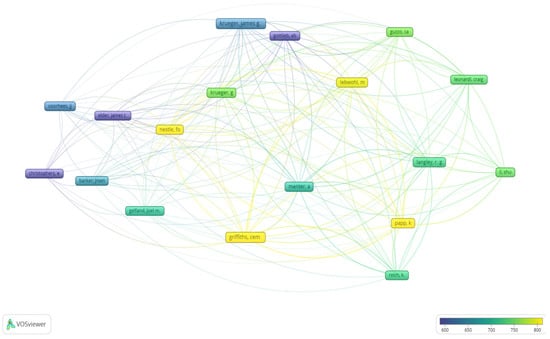
Figure 4.
Map-based representation of authors contributing to more than 5 papers scored by average citations. (Color legend: the authors that had the most citations are depicted using yellow frames, while the least cited with purple frames) [15,16,17,18,19,20,21,22,23,24,25,26,27,28,29,30,31,32,33,34,35,36,37,38,39,40,41,42,43,44,45,46,47,48,49,50,51,52,53,54,55,56,57,58,59,60,61,62,63,64,65,66,67,68,69,70,71,72,73,74,75,76,77,78,79,80,81,82,83,84,85,86,87,88,89,90,91,92,93,94,95,96,97,98,99,100,101,102,103,104,105,106,107,108,109,110,111,112,113,114].
The authors contributing to the 100 articles originated from 322 institutions and 20 countries. The United States had the most citations (48,556), as well as the highest number of papers (n = 73). Germany ranked second, with 18,722 citations from 28 articles. The top five institutions that contributed to the papers were Rockefeller University (n = 13), the University of Manchester (n = 12), Probity Medical Research (n = 11), the University of Michigan, and the University of Utah (n = 10, each). Table 4 and Figure 5 depict the top 10 institutions, respectively, countries, that contributed to the top 100 most cited articles.

Table 4.
Institutions with the most articles.
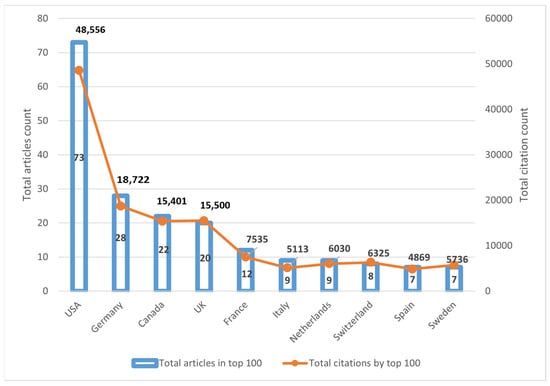
Figure 5.
Top countries by total citation count and number of articles.
3.3. Co-Word Analysis
A total of 471 unique keywords were identified from all articles. After removing keywords such as “psoriasis”, “plaque psoriasis”, “chronic plaque psoriasis”, “severe plaque psoriasis”, “vulgaris”, “to-severe psoriasis”, “psoriasis vulgaris”, and “vulgaris lesions” that could affect the analysis, a minimum threshold of two occurrences was set for each keyword and the bibliometric map was generated. Based on occurrence, they were divided into 7 clusters, as follows: cluster 1 = 37 items, cluster 2 = 28 items, cluster 3 = 23 items, cluster 4 = 19 items, cluster 5 = 18 items, cluster 6 = 12 items, and cluster 7 with 8 items. Figure 6 displays them as map-based connections, while Figure 7 displays keywords occurrence density in the selected articles. A set of the 10 most used keywords was generated and presented in Table 5.
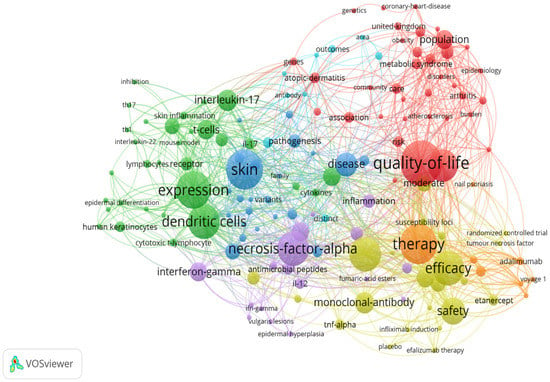
Figure 6.
The scientometric map of the keywords from the analyzed articles. (Cluster colors are as follows: cluster 1—red, cluster 2—green, cluster 3—blue, cluster 4—yellow, cluster 5—purple, cluster 6—turquoise, cluster 7—orange) [15,16,17,18,19,20,21,22,23,24,25,26,27,28,29,30,31,32,33,34,35,36,37,38,39,40,41,42,43,44,45,46,47,48,49,50,51,52,53,54,55,56,57,58,59,60,61,62,63,64,65,66,67,68,69,70,71,72,73,74,75,76,77,78,79,80,81,82,83,84,85,86,87,88,89,90,91,92,93,94,95,96,97,98,99,100,101,102,103,104,105,106,107,108,109,110,111,112,113,114].
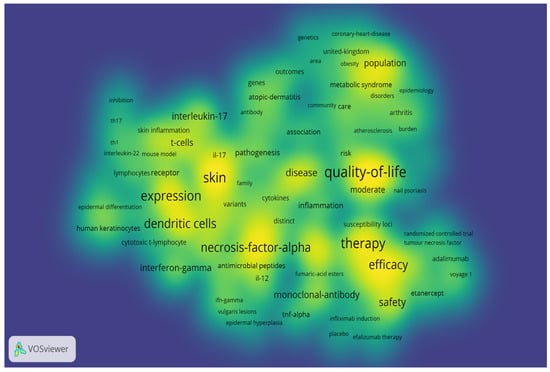
Figure 7.
Research tendency based on the density of the keywords used in the 100 articles. (Color legend: the intensity of the yellow and green colors symbolize the frequency of respective keywords).

Table 5.
Top 10 most used keywords.
3.4. Bibliographical Coupling
Based on patterns of citing the same references, the 100 articles were divided into 10 clusters. Cluster 1 consists of 26 items, cluster 2 of 23 items, cluster 3 of 16 items, cluster 4 of 14 items, cluster 5 of 13 items, cluster 6 of 4 items, and clusters 7, 8, 9, and 10 of 1 item each. The map-based connections between all clusters can be found in Figure 8.
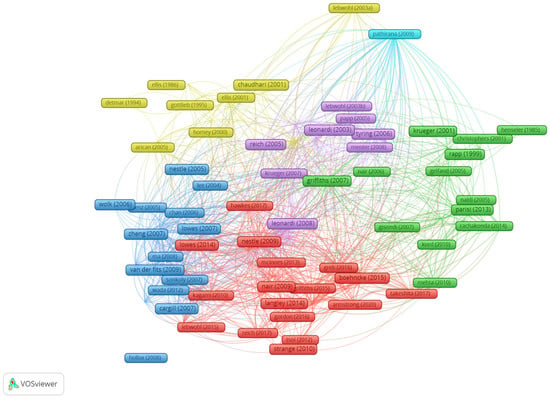
Figure 8.
The scientometric map based on existing patterns of citing the same bibliography source. (Due to a high number of bibliographic clusters that led to an overview design when exporting from VOSviewer, this figure depicts the first six clusters, as follows: cluster 1—red, cluster 2—green, cluster 3—blue, cluster 4—yellow, cluster 5—purple, cluster 6—turquoise) [15,16,17,18,19,20,21,22,23,24,25,26,27,28,29,30,31,32,33,34,35,36,37,38,39,40,41,42,43,44,45,46,47,48,49,50,51,52,53,54,56,57,58,59,60,61,62,63,64,65,66,68,69,70,71,72,73,74,75,76,78,79,80,81,82,83,84,85,86,87,88,89,90,91,92,93,94,95,96,97,98,99,100,101,102,103,104,105,107,108,109,110,111,112,113,114].
3.5. Co-Citation Analysis
The analyzed articles summed 3645 references. A minimum threshold of one for each reference was set The most co-cited reference was the article of Rapp, SR et al. [89], which was co-cited by 19 other articles, with 1077 links with other articles and a total link strength of 1358, followed by Fredrickson, T et al. [106], also co-cited by 19 articles, but with lower links (636) and link strength (804), and Gelfand, JM and Leonardi, CL both co-cited 15 times. Figure 9 shows the density of co-cited references. Co-citation frequency is depicted using different intensities of yellow and green. The network of references co-cited more than five times is shown in Figure 10, scored by average citations. They were divided into 4 clusters, as follows: cluster 1 = 43 items, cluster 2 = 30 items, cluster 3 = 30 items, and cluster 4 = 23 items. References located among different clusters and with the highest link strengths are circled with black.

Figure 9.
Co-citation tendency. (Color legend: the intensity of the yellow and green colors symbolizes the frequency of respective keywords) [15,16,17,18,19,20,21,22,23,24,25,26,27,28,29,30,31,32,33,34,35,36,37,38,39,40,41,42,43,44,45,46,47,48,49,50,51,52,53,54,55,56,57,58,59,60,61,62,63,64,65,66,67,68,69,70,71,72,73,74,75,76,77,78,79,80,81,82,83,84,85,86,87,88,89,90,91,92,93,94,95,96,97,98,99,100,101,102,103,104,105,106,107,108,109,110,111,112,113,114].

Figure 10.
The scientometric map based on co-citation patterns. (Cluster colors are as follows: cluster 1—red, cluster 2—green, cluster 3—blue, cluster 4—yellow) [15,16,17,18,19,20,21,22,23,24,25,26,27,28,29,30,31,32,33,34,35,36,37,38,39,40,41,42,43,44,45,46,47,48,49,50,51,52,53,54,55,56,57,58,59,60,61,62,63,64,65,66,67,68,69,70,71,72,73,74,75,76,77,78,79,80,81,82,83,84,85,86,87,88,89,90,91,92,93,94,95,96,97,98,99,100,101,102,103,104,105,106,107,108,109,110,111,112,113,114].
4. Discussion
Psoriasis has attracted much interest in the scientific community over the years. In the face of constant evolution and novelties added to the field, it is of great use to maintain the connection to research areas of interest. Bibliometric analysis is able to handle, using quantitative methods, large amounts of literature, to avoid bias usually associated with qualitative-based systematic reviews, and to provide the knowledge structure and future trends of a research topic or field [116].
Among the top 100 articles reviewed, pathogenesis and epidemiology were the topics most often discussed, being the focus of 66 articles. Only 12 articles focused on the clinical and diagnostic aspects of the disease. As psoriasis remains mainly a clinical diagnosis, the emphasis is on better understanding and managing the disease. This points to the fact that the vast majority of the high-impact literature focused on understanding how and why psoriasis develops. This culminated in a trend to explore the role of different immune and inflammatory pathways since the beginning of the 2000s. As key contributors to the immunopathogenesis of psoriasis, keratinocytes provide antimicrobial peptides, such as S100A7 and LL-37, that bind to host DNA and form DNA-LL-37 complexes, which stimulate dendritic cells to produce IFN-alpha and activate myeloid dendritic cells. Activated dendritic cells produce mediators, including IL-12 and IL-23, that lead to T-cells differentiation into Type 1 [35] and Type 17 T-helper cells. Th17 cells play an important role in epithelial immune surveillance [109]. A special focus was set on key pathogenic factors of psoriasis, such as TNF-α, IL-6, IL-8, IL-17, IL-22, IL-23, and IFN-gamma, providing insightful information about disease mechanisms. [51,53,61,62,105]. Additionally, 10 papers have specifically addressed [15,17,47,49,50,56,63,68,104] the genetic basis of psoriasis, with extensive genetic testing that identified more than 50 psoriasis susceptibility loci [27,49,56]. The most important one, PSORS1 [88] is located within the major histocompatibility complex (MHC) on chromosome 6p21 and is directly linked to HLA-Cw6-allele. The gene variants of interest modulate immune pathways and processes that contribute to disease susceptibilities, such as antigen presentation, the IL-23/IL-17 axis, and the type I IFN pathway [49]. A distinctive and interesting approach to psoriasis genetics has been addressed by Sonkoly et al. [68] that identified a specific, dysregulated microRNA expression profile in psoriatic skin compared to healthy skin: miR-203 and miR-125b regulate keratinocyte proliferation and differentiation, while miR-21 inhibits T cell apoptosis. Consequently, research areas referring to therapeutical means have shifted from photochemotherapy and classical immunosuppressant therapies to novel targeted therapies in the last twenty years. Of the specific therapeutic options, this analysis identified the increasingly dominant trend in reporting the use of monoclonal antibodies, twenty-six out of forty-five articles referring to treatment options were focused only on the safety and effectiveness of such novel therapies. The significance of this trend is more accurately reflected by work published in the last decade because ten out of seventeen papers published in this timeframe were focused on treatment, out of which eight addressed specifically various monoclonal antibodies.
Even though only six articles focused specifically on disease comorbidities and four on QoL it is important to mention that these aspects have been uniformly addressed over time and mentioned in other papers, suggesting a constant focus of the research community on these topics. Treatment and management of psoriasis should not address only cutaneous manifestations, but also associated comorbidities and should aim to increase the QoL [117]. Biologics represent a cornerstone in the management of this disease because apart from alleviating skin lesions they seem to work up to a certain extent for associated comorbidities as well. Research focusing on biologics seems to steal the focus in the future as well, for further exploration.
The paper of Fredriksson et al. [106], published in 1978 in Dermatologica, was the most cited article in our analysis. It explored the effectiveness of a retinoic acid derivate in treating severe psoriasis. The study was significant at the time because apart from evaluating the effectiveness of a novel retinoid, it was the first article that introduced a currently worldwide used disease severity score, Psoriasis Area Severity Index (PASI). PASI score is currently used in dermatology to assess disease severity and thus, allows the classification of psoriasis in mild, moderate, and severe. Further therapeutic options are selected taking into account various parameters, the PASI score being one of the strongest.
The oldest article included in this analysis, published by Baker et al. [45] focused on generalized pustular psoriasis and identified two etiologically and evolution-wise distinct subtypes of this rare form of psoriasis. The newest one, published by Armstrong et al. [73] offers a state-of-the-art review on clinical presentation, epidemiology, and therapeutic advancements. Due to the fact that the previously mentioned, most recent article included was published in 2020, ongoing research may significantly impact the top 100 articles over the next few years.
This study identified a significant difference in publication and citation patterns in the last two decades compared to before 2000, for which the articles total only 18 and 17.3% of the total citations. This can be explained by the fact that research published before the 2000s focused on pathogenesis, clinics, and conventional treatment options, thus laying the foundation for today’s knowledge about psoriasis. Moreover, these last two decades represent the beginning of immunopathogenesis and biologics.
The collaboration network of authors, countries, and institutions provides an overall picture of the leading researchers in this field on different levels. The United States, Germany, Canada, and the United Kingdom are leaders in the field. Additionally, the most prolific institutions and authors originate in these countries, indicating greater research resources. Moreover, these countries possess some of the most comprehensive and better-updated National Registries, allowing a proper evaluation and follow-up of patients suffering from this disease while also serving as comprehensive research databases. Even though the University of Manchester ranked second, its total link strength is higher than that of the institution ranked first, suggesting a higher connection to other institutions analyzed. The authors that published the most papers were Griffiths, CEM (n = 12), Krueger, JG (n = 12), Papp, K (n = 11), Krueger, GG (n = 10), and Menter, A (n = 10). On the other hand, when analyzing the authors who contributed to more than five papers based on citations link strength, Nestle, FO, Griffiths, CEM, Papp, K, and Lebwohl, M are proven to be the most influential scholars in their field.
Keywords are a hallmark of the literature, and their analysis can shed light on research and trends in a specific field. The analyzed articles summed up 471 keywords. After setting a minimum threshold of 2 occurrences for each keyword, a bibliometric map based on the 145 eligible items was created and presented in Figure 6. Seven clusters, each defining a research area, were defined. The top 10 keywords with the highest number of occurrences were “quality-of-life”, “skin”, “therapy”, “expression”, “dendritic cells”, “double-blind”, “efficacy”, “necrosis-factor-alpha”, “rheumatoid arthritis”, and “safety”. Figure 7 illustrates the main areas of interest based on the density of keywords in the analyzed articles, where we can observe that the research focuses on quality of life, immune pathways, and treatment safety. Reference co-citation analysis can reflect a domain’s knowledge structure and indicate research hotspots. The analysis showed that the most co-cited references were the papers of Rapp, SR “Psoriasis causes as much disability as other major medical diseases” [89] and Fredrickson, T “Severe psoriasis—oral therapy with a new retinoid” [106], both co-cited 19 times and serving as an additional indicator that treatment and life-quality are main topics in the research field. The works of Rapp, SR, Fredriksson, T, Gelfand, JM, Reich, K, Schon, MP, and Lee, E which bring attention to topics such as pathogenesis and novel treatment options, have the highest link strengths and are located among different clusters, indicating that they may serve as landmarks in the field.
The limitation of this bibliometric analysis resides mainly in the fact that only full-length English articles indexed in the WoS database have been taken into account. This has been partially addressed by not limiting article access type in any kind. Moreover, no time limit has been set when researching articles to be included in the analysis, thus a larger and more accurate overview of the research field has been obtained. To diminish the effect of time on accumulated citations, a citation rate was also calculated in order to identify articles that received a large number of citations over a short period of time. Due to the fact that bibliometric analysis covers a broad area of research, it should be taken into account that papers with the highest citations might address general topics. In order to limit this and to provide an overview of the past, present, and future of psoriasis research, we used a combination of techniques: co-citation analysis to uncover knowledge foundations, bibliographic coupling to understand the present development of themes, and co-word analysis to assess existing or future relationships among topics in psoriasis research.
5. Conclusions
Research interest in the scientific community regarding psoriasis is high, leading to the rapid and constant development of this field. This is the first bibliometric study focusing on psoriasis, providing an overview of the intellectual structure and scientific directions in the field, taking into account algorithms based on the top 100 most cited articles on the subject. The research focus is shifting from disease presentation. Treatment modalities, especially novel-targeted therapies, immune pathways, and an integrative, complex approach to such cases are receiving great interest and represent research hotspots in the future.
Author Contributions
Conceptualization: O.M.T., S.H.M. and O.S.C.; formal analysis: O.M.T.; methodology: O.M.T., C.R.M. and A.C.N.; resources: C.R.M. and R.A.T.; validation: O.S.C. and S.H.M.; visualization: O.M.T. and R.A.T.; writing—original draft: O.M.T., C.R.M. and R.A.T.; writing—revision and editing: O.M.T. and C.R.M.; supervision: O.S.C. and S.H.M. All authors have read and agreed to the published version of the manuscript.
Funding
This research received no external funding.
Institutional Review Board Statement
Not applicable.
Informed Consent Statement
Not applicable.
Data Availability Statement
All data presented can be made available upon request.
Acknowledgments
This article is part of a Ph.D. thesis from the Doctoral School of Medicine and Pharmacy of the University of Medicine, Pharmacy, Science, and Technology George Emil Palade of Targu Mures, titled “The impact of systemic inflammation in modulating disease presentation in psoriasis”, which will be presented by Oana Mirela Tiucă by the fall of 2024.
Conflicts of Interest
The authors declare no conflict of interest.
References
- WHO Organization. Global Report on Psoriasis; World Health Organization: Geneva, Switzerland, 2016. [Google Scholar]
- Damiani, G.; Bragazzi, N.L.; Karimkhani Aksut, C.; Wu, D.; Alicandro, G.; McGonagle, D.; Guo, C.; Dellavalle, R.; Grada, A.; Wong, P.; et al. The global, regional, and national burden of psoriasis: Results and insights from the global burden of disease 2019 Study. Front. Med. 2021, 8, 743180. [Google Scholar] [CrossRef]
- Mahil, S.K.; Capon, F.; Barker, J.N. Genetics of psoriasis. Dermatol. Clin. 2015, 33, 1–11. [Google Scholar] [CrossRef]
- Zeng, J.; Luo, S.; Huang, Y.; Lu, Q. Critical role of environmental factors in the pathogenesis of psoriasis. J. Dermatol. 2017, 44, 863–872. [Google Scholar] [CrossRef]
- Gisondi, P.; Fostini, A.C.; Fossà, I.; Girolomoni, G.; Targher, G. Psoriasis and the metabolic syndrome. Clin. Dermatol. 2018, 36, 21–28. [Google Scholar] [CrossRef]
- Xiaohong, L.; Zhenting, Z.; Yunjie, Y.; Wei, C.; Xiangjin, X.; Kun, X.; Xin, L.; Lu, L.; Jun, L.; Pin, C. Activation of the sting-irf3 pathway involved in psoriasis with diabetes mellitus. J. Cell. Mol. Med. 2022, 26, 2139–2151. [Google Scholar] [CrossRef]
- Pritchard, A. Statistical Bibliography or Bibliometrics? J. Doc. 1969, 25, 348–349. [Google Scholar]
- Stremersch, S.; Verniers, I.; Verhoef, P.C. The quest for citations: Drivers of article impact. J. Mark. 2007, 71, 171–193. [Google Scholar] [CrossRef]
- Fan, K.S.; Fan, K.H.; Tse, P.L.; Ding, H.; Su, R.; Kwok, H.T. Analysis of top-cited articles on melanoma. Acta Dermatovenerol. Alp. Pannonica Adriat. 2022, 31, 127–133. [Google Scholar] [CrossRef]
- Kwok, H.T.; Van, M.; Fan, K.S.; Chan, J. Top 100 cited articles in male breast cancer: A bibliometric analysis. Breast Dis. 2022, 41, 15–20. [Google Scholar] [CrossRef]
- Zhang, Y.; Yu, C. Bibliometric evaluation of publications (2000–2020) on the prognosis of gastric cancer. Inquiry 2021, 58, 469580211056015. [Google Scholar] [CrossRef] [PubMed]
- Joyce, C.W.; Sugrue, C.M.; Joyce, K.M.; Kelly, J.L.; Regan, P.J. 100 citation classics in the melanoma literature: A bibliometric analysis. Dermatol. Surg. 2014, 40, 1284–1298. [Google Scholar] [CrossRef] [PubMed]
- Cocuz, I.G.; Cocuz, M.E.; Repanovici, A.; Sabău, A.-H.; Niculescu, R.; Tinca, A.-C.; Vunvulea, V.; Budin, C.E.; Szoke, A.R.; Popelea, M.C.; et al. Scientific research directions on the histopathology and immunohistochemistry of the cutaneous squamous cell carcinoma: A scientometric study. Medicina 2022, 58, 1449. [Google Scholar] [CrossRef]
- Paladugu, R.; Schein, M.; Gardezi, S.; Wise, L. One hundred citation classics in general surgical journals. World J. Surg. 2002, 26, 1099–1105. [Google Scholar] [CrossRef]
- Strange, A.; Capon, F.; Spencer, C.C.A.; Knight, J.; Weale, M.E.; Allen, M.H.; Barton, A.; Band, G.; Bellenguez, C.; Bergboer, J.G.M.; et al. A genome-wide association study identifies new psoriasis susceptibility loci and an interaction between HLA-C and ERAP1. Nat. Genet 2010, 42, 985–990. [Google Scholar]
- Papp, K.; Tyring, S.; Lahfa, M.; Prinz, J.; Griffiths, C.; Nakanishi, A.; Zitnik, R.; van de Kerkhof, P.; Grp, E.P.S. A global phase iii randomized controlled trial of etanercept in psoriasis: Safety, efficacy, and effect of dose reduction. Br. J. Dermatol. 2005, 152, 1304–1312. [Google Scholar] [CrossRef]
- Cargill, M.; Schrodi, S.J.; Chang, M.; Garcia, V.E.; Brandon, R.; Callis, K.P.; Matsunami, N.; Ardlie, K.G.; Civello, D.; Catanese, J.J.; et al. A large-scale genetic association study confirms il12b and leads to the identification of il23r as psoriasis-risk genes. Am. J. Hum. Genet 2007, 80, 273–290. [Google Scholar] [CrossRef]
- Krueger, G.G.; Langley, R.G.; Leonardi, C.; Yeilding, N.; Guzzo, C.; Wang, Y.; Dooley, L.T.; Lebwohl, M.; Grp, C. 1275 P. S. A human interleukin-12/23 monoclonal antibody for the treatment of psoriasis. N. Engl. J. Med. 2007, 356, 580–592. [Google Scholar] [CrossRef]
- Lebwohl, M.; Tyring, S.; Hamilton, T.; Toth, D.; Glazer, S.; Tawfik, N.; Walicke, P.; Dummer, W.; Wang, X.; Garovoy, M.; et al. A novel targeted T-cell modulator, efalizumab, for plaque psoriasis. N. Engl. J. Med. 2003, 349, 2004–2013. [Google Scholar] [CrossRef]
- Michalek, I.M.; Loring, B.; John, S.M. A systematic review of worldwide epidemiology of psoriasis. J. Eur. Acad. Dermatol. Venereol. 2017, 31, 205–212. [Google Scholar] [CrossRef]
- Menter, A.; Tyring, S.K.; Gordon, K.; Kimball, A.B.; Leonardi, C.L.; Langley, R.G.; Strober, B.E.; Kaul, M.; Gu, Y.; Okun, M.; et al. Adalimumab therapy for moderate to severe psoriasis: A randomized, controlled phase iii trial. J. Am. Acad. Dermatol. 2008, 58, 106–115. [Google Scholar] [CrossRef]
- Leonardi, C.; Matheson, R.; Zachariae, C.; Cameron, G.; Li, L.; Edson-Heredia, E.; Braun, D.; Banerjee, S. Anti-interleukin-17 monoclonal antibody ixekizumab in chronic plaque psoriasis. N. Engl. J. Med. 2012, 366, 1190–1199. [Google Scholar] [CrossRef]
- Nickoloff, B.; Karabin, G.; Barker, J.; Griffiths, C.; Sarma, V.; Mitra, R.; Elder, J.; Kunkel, S.; Dixit, V. Cellular-localization of interleukin-8 and its inducer, tumor-necrosis-factor-alpha in psoriasis. Am. J. Pathol. 1991, 138, 129–140. [Google Scholar]
- Wada, Y.; Cardinale, I.; Khatcherian, A.; Chu, J.; Kantor, A.B.; Gottlieb, A.B.; Tatsuta, N.; Jacobson, E.; Barsoum, J.; Krueger, J.G. Apilimod inhibits the production of il-12 and il-23 and reduces dendritic cell infiltration in psoriasis. PLoS ONE 2012, 7, e35069. [Google Scholar] [CrossRef]
- Papp, K.A.; Leonardi, C.; Menter, A.; Ortonne, J.-P.; Krueger, J.G.; Kricorian, G.; Aras, G.; Li, J.; Russell, C.B.; Thompson, E.H.Z.; et al. Brodalumab, an anti-interleukin-17-receptor antibody for psoriasis. N. Engl. J. Med. 2012, 366, 1181–1189. [Google Scholar] [CrossRef]
- Naldi, L.; Chatenoud, L.; Linder, D.; Fortina, A.; Peserico, A.; Virgili, A.; Bruni, P.; Ingordo, V.; Lo Scocco, G.; Solaroli, C.; et al. Cigarette smoking, body mass index, and stressful life events as risk factors for psoriasis: Results from an italian case-control study. J. Investig. Dermatol. 2005, 125, 61–67. [Google Scholar] [CrossRef]
- Kagami, S.; Rizzo, H.L.; Lee, J.J.; Koguchi, Y.; Blauvelt, A. Circulating Th17, Th22, and Th1 cells are increased in psoriasis. J. Investig. Dermatol. 2010, 130, 1373–1383. [Google Scholar] [CrossRef]
- Gordon, K.B.; Langley, R.G.; Leonardi, C.; Toth, D.; Menter, M.A.; Kang, S.; Heffernan, M.; Miller, B.; Hamlin, R.; Lim, L.; et al. Clinical response to adalimumab treatment in patients with moderate to severe psoriasis: Double-blind, randomized controlled trial and open-label extension study. J. Am. Acad. Dermatol. 2006, 55, 598–606. [Google Scholar] [CrossRef]
- Griffiths, C.E.M.; Reich, K.; Lebwohl, M.; van de Kerkhof, P.; Paul, C.; Menter, A.; Cameron, G.S.; Erickson, J.; Zhang, L.; Secrest, R.J.; et al. Comparison of ixekizumab with etanercept or placebo in moderate-to-severe psoriasis (UNCOVER-2 and UNCOVER-3): Results from two phase 3 randomised trials. Lancet 2015, 386, 541–551. [Google Scholar] [CrossRef]
- Griffiths, C.E.M.; Strober, B.E.; van de Kerkhof, P.; Ho, V.; Fidelus-Gort, R.; Yeilding, N.; Guzzo, C.; Xia, Y.; Zhou, B.; Li, S.; et al. Comparison of ustekinumab and etanercept for moderate-to-severe psoriasis. N. Engl. J. Med. 2010, 362, 118–128. [Google Scholar] [CrossRef]
- Abrams, J.; Lebwohl, M.; Guzzo, C.; Jegasothy, B.; Goldfarb, M.; Goffe, B.; Menter, A.; Lowe, N.; Krueger, G.; Brown, M.; et al. CTLA4ig-mediated blockade of T-cell costimulation in patients with psoriasis vulgaris. J. Clin. Investig. 1999, 103, 1243–1252. [Google Scholar] [CrossRef]
- Ellis, C.; Gorsulowsky, D.; Hamilton, T.; Billings, J.; Brown, M.; Headington, J.; Cooper, K.; Baadsgaard, O.; Duell, E.; Annesley, T.; et al. Cyclosporine improves psoriasis in a double-blind-study. JAMA-J. Am. Med. Assoc. 1986, 256, 3110–3116. [Google Scholar] [CrossRef]
- Mrowietz, U.; Kragballe, K.; Reich, K.; Spuls, P.; Griffiths, C.E.M.; Nast, A.; Franke, J.; Antoniou, C.; Arenberger, P.; Balieva, F.; et al. Definition of treatment goals for moderate to severe psoriasis: A european consensus. Arch. Dermatol. Res. 2011, 303, 1–10. [Google Scholar] [CrossRef]
- Henseler, T.; Christophers, E. Disease concomitance in psoriasis. J. Am. Acad. Dermatol. 1995, 32, 982–986. [Google Scholar] [CrossRef]
- Sugiyama, H.; Gyulai, R.; Toichi, E.; Garaczi, E.; Shimada, S.; Stevens, S.; McCormick, T.; Cooper, K. Dysfunctional blood and target tissue CD4(+)CD25(high) regulatory T cells in psoriasis: Mechanism underlying unrestrained pathogenic effector t cell proliferation. J. Immunol. 2005, 174, 164–173. [Google Scholar] [CrossRef]
- Blauvelt, A.; Papp, K.A.; Griffiths, C.E.M.; Randazzo, B.; Wasfi, Y.; Shen, Y.-K.; Li, S.; Kimball, A.B. Efficacy and safety of guselkumab, an anti-interleukin-23 monoclonal antibody, compared with adalimumab for the continuous treatment of patients with moderate to severe psoriasis: Results from the phase iii, double-blinded, placebo- and active comparatore-controlled voyage 1 trial. J. Am. Acad. Dermatol. 2017, 76, 405–417. [Google Scholar]
- Reich, K.; Armstrong, A.W.; Foley, P.; Song, M.; Wasfi, Y.; Randazzo, B.; Li, S.; Shen, Y.K.; Gordon, K.B. Efficacy and safety of guselkumab, an anti-interleukin-23 monoclonal antibody, compared with adalimumab for the treatment of patients with moderate to severe psoriasis with randomized withdrawal and retreatment: Results from the phase iii, double-blind, placebo- and active comparatore-controlled voyage 2 trial. J. Am. Acad. Dermatol. 2017, 76, 418–431. [Google Scholar]
- McInnes, I.B.; Kavanaugh, A.; Gottlieb, A.B.; Puig, L.; Rahman, P.; Ritchlin, C.; Brodmerkel, C.; Li, S.; Wang, Y.; Mendelsohn, A.M.; et al. Efficacy and safety of ustekinumab in patients with active psoriatic arthritis: 1 year results of the phase 3, multicentre, double-blind, placebo-controlled psummit 1 trial. Lancet 2013, 382, 780–789. [Google Scholar] [CrossRef]
- Chaudhari, U.; Romano, P.; Mulcahy, L.; Dooley, L.; Baker, D.; Gottlieb, A. Efficacy and safety of infliximab monotherapy for plaque-type psoriasis: A randomised trial. Lancet 2001, 357, 1842–1847. [Google Scholar] [CrossRef]
- Papp, K.A.; Langley, R.G.; Lebwohl, M.; Krueger, G.G.; Szapary, P.; Yeilding, N.; Guzzo, C.; Hsu, M.-C.; Wang, Y.; Li, S.; et al. Efficacy and safety of ustekinumab, a human interleukin-12/23 monoclonal antibody, in patients with psoriasis: 52-week results from a randomised, double-blind, placebo-controlled trial (Phoenix 2). Lancet 2008, 371, 1675–1684. [Google Scholar] [CrossRef]
- Leonardi, C.L.; Kimball, A.B.; Papp, K.A.; Yeilding, N.; Guzzo, C.; Wang, Y.; Li, S.; Dooley, L.T.; Gordon, K.B.; PHOENIX 1 study investigators. Efficacy and safety of ustekinumab, a human interleukin-12/23 monoclonal antibody, in patients with psoriasis: 76-week results from a randomised, double-blind, placebo-controlled trial (phoenix 1). Lancet 2008, 371, 1665–1674. [Google Scholar] [CrossRef]
- Tyring, S.; Gottlieb, A.; Papp, K.; Gordon, K.; Leonardi, C.; Wang, A.; Lalla, D.; Woolley, M.; Jahreis, A.; Zitnik, R.; et al. Etanercept and clinical outcomes, fatigue, and depression in psoriasis: Double-blind placebo-controlled randomised phase III trial. Lancet 2006, 367, 29–35. [Google Scholar] [CrossRef]
- Saurat, J.-H.; Stingl, G.; Dubertret, L.; Papp, K.; Langley, R.G.; Ortonne, J.-P.; Unnebrink, K.; Kaul, M.; Camez, A.; Invest, C.S. Efficacy and safety results from the randomized controlled comparative study of adalimumab vs. Methotrexate vs. Placebo in patients with psoriasis (champion). Br. J. Dermatol. 2008, 158, 558–566. [Google Scholar] [CrossRef]
- Leonardi, C.; Powers, J.; Matheson, R.; Goffe, B.; Zitnik, R.; Wang, A.; Gottlieb, A.; Bagel, J.; Camisa, C.; Caro, I.; et al. Etanercept as monotherapy in patients with psoriasis. N. Engl. J. Med. 2003, 349, 2014–2022. [Google Scholar] [CrossRef]
- Baker, H.; Ryan, T. Generalized pustular psoriasis—A clinical and epidemiological study of 104 cases. Br. J. Dermatol. 1968, 80, 771–793. [Google Scholar] [CrossRef]
- Pathirana, D.; Ormerod, A.D.; Saiag, P.; Smith, C.; Spuls, P.I.; Nast, A.; Barker, J.; Bos, J.D.; Burmester, G.-R.; Chimenti, S.; et al. European S3-guidelines on the systemic treatment of psoriasis vulgaris. J. Eur. Acad. Dermatol. Venereol. 2009, 23, 5–70. [Google Scholar] [CrossRef]
- Nair, R.P.; Duffin, K.C.; Helms, C.; Ding, J.; Stuart, P.E.; Goldgar, D.; Gudjonsson, J.E.; Li, Y.; Tejasvi, T.; Feng, B.-J.; et al. Genome-wide scan reveals association of psoriasis with IL-23 and NF-kappa B pathways. Nat. Genet 2009, 41, 199–204. [Google Scholar] [CrossRef]
- Parisi, R.; Symmons, D.P.M.; Griffiths, C.E.M.; Ashcroft, D.M.; Management, I. Global epidemiology of psoriasis: A systematic review of incidence and prevalence. J. Investig. Dermatol. 2013, 133, 377–385. [Google Scholar] [CrossRef]
- Tsoi, L.C.; Spain, S.L.; Knight, J.; Ellinghaus, E.; Stuart, P.E.; Capon, F.; Ding, J.; Li, Y.; Tejasvi, T.; Gudjonsson, J.E.; et al. Identification of 15 new psoriasis susceptibility loci highlights the role of innate immunity. Nat. Genet 2012, 44, 1341–1348. [Google Scholar] [CrossRef]
- Trembath, R.; Clough, R.; Rosbotham, J.; Jones, A.; Camp, R.; Frodsham, A.; Browne, J.; Barber, R.; Terwilliger, J.; Lathrop, G.; et al. Identification of a major susceptibility locus on chromosome 6p and evidence for further disease loci revealed by a two stage genome-wide search in psoriasis. Hum. Mol. Genet 1997, 6, 813–820. [Google Scholar] [CrossRef]
- Ma, H.-L.; Liang, S.; Li, J.; Napierata, L.; Brown, T.; Benoit, S.; Senices, M.; Gill, D.; Dunussi-Joannopoulos, K.; Collins, M.; et al. Il-22 is required for th17 cell-mediated pathology in a mouse model of psoriasis-like skin inflammation. J. Clin. Investig. 2008, 118, 597–607. [Google Scholar] [CrossRef]
- Wolk, K.; Witte, E.; Wallace, E.; Doecke, W.-D.; Kunz, S.; Asadullah, K.; Volk, H.-D.; Sterry, W.; Sabat, R. Il-22 regulates the expression of genes responsible for antimicrobial defense, cellular differentiation, and mobility in keratinocytes: A potential role in psoriasis. Eur. J. Immunol. 2006, 36, 1309–1323. [Google Scholar] [CrossRef]
- Chan, J.R.; Blumenschein, W.; Murphy, E.; Diveu, C.; Wiekowski, M.; Abbondanzo, S.; Lucian, L.; Geissler, R.; Brodie, S.; Kimball, A.B.; et al. IL-23 stimulates epidermal hyperplasia via TNF and IL-20R2-dependent mechanisms with implications for psoriasis pathogenesis. J. Exp. Med. 2006, 203, 2577–2587. [Google Scholar] [CrossRef]
- van der Fits, L.; Mourits, S.; Voerman, J.S.A.; Kant, M.; Boon, L.; Laman, J.D.; Cornelissen, F.; Mus, A.-M.; Florencia, E.; Prens, E.P.; et al. Imiquimod-induced psoriasis-like skin inflammation in mice is mediated via the Il-23/Il-17 Axis. J. Immunol. 2009, 182, 5836–5845. [Google Scholar] [CrossRef]
- Hammarstrom, S.; Hamberg, M.; Samuelsson, B.; Duell, E.; Stawiski, M.; Voorhees, J. Increased concentrations of nonesterified arachidonic-acid, 12l-Hydroxy-5,8,10,14-eicosatetraenoic acid, prostaglandin-E2, and prostaglandin-F2alpha in epidermis of psoriasis. Proc. Natl. Acad. Sci. USA 1975, 72, 5130–5134. [Google Scholar] [CrossRef]
- Lowes, M.A.; Suarez-Farinas, M.; Krueger, J.G. Immunology of Psoriasis. Annu. Rev. Immunol. 2014, 32, 227–255. [Google Scholar] [CrossRef]
- Lee, E.; Trepicchio, W.; Oestreicher, J.; Pittman, D.; Wang, F.; Chamian, F.; Dhodapkar, M.; Krueger, J. Increased Expression of Interleukin 23 P19 and P40 in Lesional Skin of Patients with Psoriasis Vulgaris. J. Exp. Med. 2004, 199, 125–130. [Google Scholar] [CrossRef]
- Sommer, D.M.; Jenisch, S.; Suchan, M.; Christophers, E.; Weichenthal, M. Increased prevalence of the metabolic syndrome in patients with moderate to severe psoriasis. Arch. Dermatol. Res. 2006, 298, 321–328. [Google Scholar] [CrossRef]
- Gottlieb, A.; Evans, R.; Li, S.; Dooley, L.; Guzzo, C.; Baker, D.; Bala, M.; Marano, C.; Menter, A. Infliximab induction therapy for patients with severe plaque-type psoriasis: A randomized, double-blind, placebo-controlled trial. J. Am. Acad. Dermatol. 2004, 51, 534–542. [Google Scholar] [CrossRef]
- Reich, K.; Nestle, F.; Papp, K.; Ortonne, J.; Evans, R.; Guzzo, C.; Li, S.; Dooley, L.; Griffiths, C.; Investigators, E.S. Infliximab induction and maintenance therapy for moderate-to-severe psoriasis: A phase iii, multicentre, double-blind trial. Lancet 2005, 366, 1367–1374. [Google Scholar] [CrossRef]
- Chiricozzi, A.; Guttman-Yassky, E.; Suarez-Farinas, M.; Nograles, K.E.; Tian, S.; Cardinale, I.; Chimenti, S.; Krueger, J.G. Integrative responses to il-17 and tnf-alpha in human keratinocytes account for key inflammatory pathogenic circuits in psoriasis. J. Investig. Dermatol. 2011, 131, 677–687. [Google Scholar] [CrossRef]
- Zheng, Y.; Danilenko, D.M.; Valdez, P.; Kasman, I.; Eastham-Anderson, J.; Wu, J.; Ouyang, W. Interleukin-22, a t(h)17 cytokine, mediates il-23-induced dermal inflammation and acanthosis. Nature 2007, 445, 648–651. [Google Scholar] [CrossRef]
- Marrakchi, S.; Guigue, P.; Renshaw, B.R.; Puel, A.; Pei, X.-Y.; Fraitag, S.; Zribi, J.; Bal, E.; Cluzeau, C.; Chrabieh, M.; et al. Interleukin-36-receptor antagonist deficiency and generalized pustular psoriasis. N. Engl. J. Med. 2011, 365, 620–628. [Google Scholar] [CrossRef]
- Stern, R.; Nichols, K.; Vakeva, L. Malignant melanoma in patients treated for psoriasis with methoxsalen (psoralen) and ultraviolet a radiation (puva). N. Engl. J. Med. 1997, 336, 1041–1045. [Google Scholar] [CrossRef]
- Lin, A.M.; Rubin, C.J.; Khandpur, R.; Wang, J.Y.; Riblett, M.; Yalavarthi, S.; Villanueva, E.C.; Shah, P.; Kaplan, M.J.; Bruce, A.T. Mast cells and neutrophils release il-17 through extracellular trap formation in psoriasis. J. Immunol. 2011, 187, 490–500. [Google Scholar] [CrossRef]
- Nestle, F.O.; Kaplan, D.H.; Barker, J. Mechanisms of disease: Psoriasis. N. Engl. J. Med. 2009, 361, 496–509. [Google Scholar] [CrossRef]
- Schon, M.; Boehncke, W. Medical Progress—Psoriasis. N. Engl. J. Med. 2005, 352, 1899–1912. [Google Scholar] [CrossRef]
- Sonkoly, E.; Wei, T.; Janson, P.C.J.; Saaf, A.; Lundeberg, L.; Tengvall-Linder, M.; Norstedt, G.; Alenius, H.; Homey, B.; Scheynius, A.; et al. Micrornas: Novel regulators involved in the pathogenesis of psoriasis? PLoS ONE 2007, 2, e610. [Google Scholar] [CrossRef]
- Farber, E.; Nall, M. Natural-History of Psoriasis in 5600 Patients. Dermatologica 1974, 148, 1–18. [Google Scholar] [CrossRef]
- Melski, J.; Tanenbaum, L.; Parrish, J.; Fitzpatrick, T.; Bleich, H. Oral methoxsalen photochemotherapy for treatment of psoriasis—Cooperative clinical-trial. J. Investig. Dermatol. 1977, 68, 328–335. [Google Scholar]
- Detmar, M.; Brown, L.; Claffey, K.; Yee, K.; Kocher, O.; Jackman, R.; Berse, B.; Dvorak, H. Overexpression of vascular-permeability factor vascular endothelial growth-factor and its receptors in psoriasis. J. Exp. Med. 1994, 180, 1141–1146. [Google Scholar] [CrossRef]
- Lowes, M.A.; Bowcock, A.M.; Krueger, J.G. Pathogenesis and therapy of psoriasis. Nature 2007, 445, 866–873. [Google Scholar] [CrossRef]
- Armstrong, A.W.; Read, C. Pathophysiology, clinical presentation, and treatment of psoriasis a review. JAMA-J. Am. Med. Assoc. 2020, 323, 1945–1960. [Google Scholar] [CrossRef]
- Mehta, N.N.; Azfar, R.S.; Shin, D.B.; Neimanns, A.L.; Troxel, A.B.; Gelfand, J.M. Patients with severe psoriasis are at increased risk of cardiovascular mortality: Cohort study using the general practice research database. Eur. Heart J. 2010, 31, 1000–1006. [Google Scholar] [CrossRef]
- Lebwohl, M.; Strober, B.; Menter, A.; Gordon, K.; Weglowska, J.; Puig, L.; Papp, K.; Spelman, L.; Toth, D.; Kerdel, F.; et al. Phase 3 studies comparing brodalumab with ustekinumab in psoriasis. N. Engl. J. Med. 2015, 373, 1318–1328. [Google Scholar] [CrossRef]
- Gordon, K.B.; Blauvelt, A.; Papp, K.A.; Langley, R.G.; Luger, T.; Ohtsuki, M.; Reich, K.; Amato, D.; Ball, S.G.; Braun, D.K.; et al. Phase 3 trials of Ixekizumab in moderate-to-severe plaque psoriasis. N. Engl. J. Med. 2016, 375, 345–356. [Google Scholar] [CrossRef]
- Parrish, J.; Fitzpatrick, T.; Tanenbaum, L.; Pathak, M. Photochemotherapy of psoriasis with oral methoxsalen and longwave ultraviolet-light. N. Engl. J. Med. 1974, 291, 1207–1211. [Google Scholar] [CrossRef]
- Nestle, F.; Conrad, C.; Tun-Kyi, A.; Homey, B.; Gombert, M.; Boyman, O.; Burg, G.; Liu, Y.; Gilliet, M. Plasmacytoid predendritic cells initiate psoriasis through interferon-alpha production. J. Exp. Med. 2005, 202, 135–143. [Google Scholar] [CrossRef]
- Gelfand, J.; Weinstein, R.; Porter, S.; Neimann, A.; Berlin, J.; Margolis, D. Prevalence and treatment of psoriasis in the united kingdom—A population-based study. Arch. Dermatol. 2005, 141, 1537–1541. [Google Scholar] [CrossRef]
- Neimann, A.L.; Shin, D.B.; Wang, X.; Margolis, D.J.; Troxel, A.B.; Gelfand, J.M. Prevalence of cardiovascular risk factors in patients with psoriasis. J. Am. Acad. Dermatol. 2006, 55, 829–835. [Google Scholar] [CrossRef]
- Boehncke, W.H.; Schoen, M.P. Psoriasis. Lancet 2015, 386, 983–994. [Google Scholar] [CrossRef]
- Gisondi, P.; Tessari, G.; Conti, A.; Piaserico, S.; Schianchi, S.; Peserico, A.; Giannetti, A.; Girolomoni, G. Prevalence of metabolic syndrome in patients with psoriasis: A hospital-based case-control study. Br. J. Dermatol. 2007, 157, 68–73. [Google Scholar] [CrossRef]
- Greb, J.E.; Goldminz, A.M.; Elder, J.T.; Lebwohl, M.G.; Gladman, D.D.; Wu, J.J.; Mehta, N.N.; Finlay, A.Y.; Gottlieb, A.B. Psoriasis. Nat. Rev. Dis. Prim. 2016, 2, 16082. [Google Scholar] [CrossRef]
- Lebwohl, M. Psoriasis. Lancet 2003, 361, 1197–1204. [Google Scholar] [CrossRef]
- Griffiths, C.; Barker, J. Psoriasis 1—Pathogenesis and clinical features of Psoriasis. Lancet 2007, 370, 263–271. [Google Scholar] [CrossRef]
- Christophers, E. Psoriasis—Epidemiology and clinical spectrum. Clin. Exp. Dermatol. 2001, 26, 314–320. [Google Scholar] [CrossRef]
- Takeshita, J.; Grewal, S.; Langan, S.M.; Mehta, N.N.; Ogdie, A.; Van Voorhees, A.S.; Gelfand, J.M. Psoriasis and comorbid diseases epidemiology. J. Am. Acad. Dermatol. 2017, 76, 377–390. [Google Scholar] [CrossRef]
- Davidovici, B.B.; Sattar, N.; Joerg, P.C.; Puig, L.; Emery, P.; Barker, J.N.; van de Kerkhof, P.; Stahle, M.; Nestle, F.O.; Girolomoni, G.; et al. Psoriasis and systemic inflammatory diseases: Potential mechanistic links between skin disease and co-morbid conditions. J. Investig. Dermatol. 2010, 130, 1785–1796. [Google Scholar] [CrossRef]
- Rapp, S.; Feldman, S.; Exum, M.; Fleischer, A.; Reboussin, D. Psoriasis causes as much disability as other major medical diseases. J. Am. Acad. Dermatol. 1999, 41, 401–407. [Google Scholar] [CrossRef]
- Hollox, E.J.; Huffmeier, U.; Zeeuwen, P.L.J.M.; Palla, R.; Lascorz, J.; Rodijk-Olthuis, D.; van de Kerkhof, P.C.M.; Traupe, H.; de Jongh, G.; den Heijer, M.; et al. Psoriasis is associated with increased beta-defensin genomic copy number. Nat. Genet 2008, 40, 23–25. [Google Scholar] [CrossRef]
- Stern, R.; Nijsten, T.; Feldman, S.; Margolis, D.; Rolstad, T. Psoriasis is common, carries a substantial burden even when not extensive, and is associated with widespread treatment dissatisfaction. J. Investig. Dermatol. Symp. Proc. 2004, 9, 136–139. [Google Scholar] [CrossRef]
- Henseler, T.; Christophers, E. Psoriasis of early and late onset—Characterization of 2 types of psoriasis-vulgaris. J. Am. Acad. Dermatol. 1985, 13, 450–456. [Google Scholar] [CrossRef]
- Hawkes, J.E.; Chan, T.C.; Krueger, J.G. Psoriasis pathogenesis and the development of novel targeted immune therapies. J. Allergy Clin. Immunol. 2017, 140, 645–653. [Google Scholar] [CrossRef]
- Rendon, A.; Schaekel, K. Psoriasis pathogenesis and treatment. Int. J. Mol. Sci. 2019, 20, 1475. [Google Scholar] [CrossRef]
- Rachakonda, T.D.; Schupp, C.W.; Armstrong, A.W. Psoriasis prevalence among adults in The United States. J. Am. Acad. Dermatol. 2014, 70, 512–516. [Google Scholar] [CrossRef]
- Lowes, M.A.; Kikuchi, T.; Fuentes-Duculan, J.; Cardinale, I.; Zaba, L.C.; Haider, A.S.; Bowman, E.P.; Krueger, J.G. Psoriasis vulgaris lesions contain discrete populations of Th1 and Th17 T cells. J. Investig. Dermatol. 2008, 128, 1207–1211. [Google Scholar] [CrossRef]
- Zenz, R.; Eferl, R.; Kenner, L.; Florin, L.; Hummerich, L.; Mehic, D.; Scheuch, H.; Angel, P.; Tschachler, E.; Wagner, E. Psoriasis-like skin disease and arthritis caused by inducible epidermal deletion of jun proteins. Nature 2005, 437, 369–375. [Google Scholar] [CrossRef]
- Langley, R.; Krueger, G.; Griffiths, C. Psoriasis: Epidemiology, clinical features, and quality of life. Ann. Rheum. Dis. 2005, 64, 18–23. [Google Scholar] [CrossRef]
- Nickoloff, B.; Nestle, F. Recent insights into the immunopathogenesis of psoriasis provide new therapeutic opportunities. J. Clin. Investig. 2004, 113, 1664–1675. [Google Scholar] [CrossRef]
- Gottlieb, S.; Gilleaudeau, P.; Johnson, R.; Estes, L.; Woodworth, T.; Gottlieb, A.; Krueger, J. Response of psoriasis to a lymphocyte-selective toxin (dab(389)il-2) suggests a primary immune, but not keratinocyte, pathogenic basis. Nat. Med. 1995, 1, 442–447. [Google Scholar] [CrossRef]
- Stern, R.; Thibodeau, L.; Kleinerman, R.; Parrish, J.; Fitzpatrick, T. Risk of cutaneous carcinoma in patients treated with oral methoxsalen photochemotherapy for Psoriasis. N. Engl. J. Med. 1979, 300, 809–813. [Google Scholar] [CrossRef]
- Gelfand, J.M.; Neimann, A.L.; Shin, D.B.; Wang, X.; Margolis, D.J.; Troxel, A.B. Risk of myocardial infarction in patients with psoriasis. JAMA-J. Am. Med. Assoc. 2006, 296, 1735–1741. [Google Scholar] [CrossRef]
- Langley, R.G.; Elewski, B.E.; Lebwohl, M.; Reich, K.; Griffiths, C.E.M.; Papp, K.; Puig, L.; Nakagawa, H.; Spelman, L.; Sigurgeirsson, B.; et al. Secukinumab in plaque psoriasis—Results of two phase 3 trials. N. Engl. J. Med. 2014, 371, 326–338. [Google Scholar] [CrossRef]
- Nair, R.; Stuart, P.; Nistor, I.; Hiremagalore, R.; Chia, N.; Jenisch, S.; Weichenthal, M.; Abecasis, G.; Lim, H.; Christophers, E.; et al. Sequence and haplotype analysis supports hla-c as the psoriasis susceptibility 1 gene. Am. J. Hum. Genet 2006, 78, 827–851. [Google Scholar] [CrossRef]
- Arican, O.; Aral, M.; Sasmaz, S.; Ciragil, P. Serum Levels of TNF-Alpha, IFN-gamma, IL-6, IL-8, IL-12, IL-17 and IL-18 in patients with active psoriasis and correlation with disease severity. Mediat. Inflamm. 2005, 2005, 273–279. [Google Scholar] [CrossRef]
- Fredriksson, T.; Pettersson, U. Severe psoriasis—Oral therapy with a new retinoid. Dermatologica 1978, 157, 238–244. [Google Scholar] [CrossRef]
- Sano, S.; Chan, K.; Carbajal, S.; Clifford, J.; Peavey, M.; Kiguchi, K.; Itami, S.; Nickoloff, B.; DiGiovanni, J. STATt3 links activated keratinocytes and immunocytes required for development of psoriasis in a novel transgenic mouse model. Nat. Med. 2005, 11, 43–49. [Google Scholar] [CrossRef]
- Nograles, K.E.; Zaba, L.C.; Guttman-Yassky, E.; Fuentes-Duculan, J.; Suarez-Farinas, M.; Cardinale, I.; Khatcherian, A.; Gonzalez, J.; Pierson, K.C.; White, T.R.; et al. Th17 cytokines interleukin (IL)-17 and IL-22 modulate distinct inflammatory and keratinocyte-response pathways. Br. J. Dermatol. 2008, 159, 1092–1102. [Google Scholar] [CrossRef]
- Di Cesare, A.; Di Meglio, P.; Nestle, F.O. The IL-23/Th17 axis in the immunopathogenesis of psoriasis. J. Investig. Dermatol. 2009, 129, 1339–1350. [Google Scholar] [CrossRef]
- Krueger, G.; Koo, J.; Lebwohl, M.; Menter, A.; Stern, R.; Rolstad, T. The impact of psoriasis on quality of life—Results of a 1998 national psoriasis foundation patient-membership survey. Arch. Dermatol. 2001, 137, 280–284. [Google Scholar]
- Krueger, J. The immunologic basis for the treatment of psoriasis with new biologic agents. J. Am. Acad. Dermatol. 2002, 46, 1–26. [Google Scholar] [CrossRef]
- Kurd, S.K.; Troxel, A.B.; Crits-Christoph, P.; Gelfand, J.M. The risk of depression, anxiety, and suicidality in patients with psoriasis a population-based cohort study. Arch. Dermatol. 2010, 146, 891–895. [Google Scholar]
- Ellis, C.; Krueger, G.; Grp, A.C.S. Treatment of chronic plaque psoriasis by selective targeting of memory effector T lymphocytes. N. Engl. J. Med. 2001, 345, 248–255. [Google Scholar] [CrossRef]
- Homey, B.; Dieu-Nosjean, M.; Wiesenborn, A.; Massacrier, C.; Pin, J.; Oldham, E.; Catron, D.; Buchanan, M.; Muller, A.; Malefyt, R.; et al. Up-regulation of macrophage inflammatory protein-3 alpha/ccl20 and cc chemokine receptor 6 in psoriasis. J. Immunol. 2000, 164, 6621–6632. [Google Scholar] [CrossRef]
- Van Eck, N.J.; Waltman, L. Software Survey: Vosviewer, a computer program for bibliometric mapping. Scientometrics 2010, 84, 523–538. [Google Scholar] [CrossRef]
- Donthu, N.; Kumar, S.; Mukherjee, D.; Pandey, N.; Lim, W.M. How to conduct a bibliometric analysis: An overview and guidelines. J. Bus. Res. 2021, 133, 285–296. [Google Scholar] [CrossRef]
- Reid, C.; Griffiths, C.E.M. Psoriasis and treatment: Past, present and future aspects. Acta Dermatol. Venereol. 2020, 100, Adv00032. [Google Scholar] [CrossRef]
Disclaimer/Publisher’s Note: The statements, opinions and data contained in all publications are solely those of the individual author(s) and contributor(s) and not of MDPI and/or the editor(s). MDPI and/or the editor(s) disclaim responsibility for any injury to people or property resulting from any ideas, methods, instructions or products referred to in the content. |
© 2023 by the authors. Licensee MDPI, Basel, Switzerland. This article is an open access article distributed under the terms and conditions of the Creative Commons Attribution (CC BY) license (https://creativecommons.org/licenses/by/4.0/).